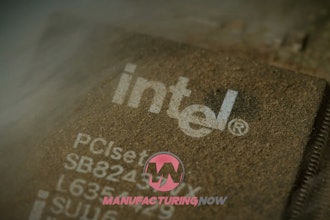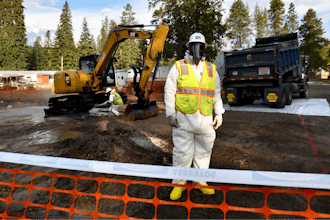
 Adam Fleder, President, TEGAM, Inc.
Adam Fleder, President, TEGAM, Inc.What are the costs of foodborne illnesses? A recent Fortune.com article placed the annual cost of medical treatment, lost productivity, and illness-related mortality for affected consumers at $55.5 billion.[1] The industry takes a hit as well to the tune of $7 billion in annual costs from food withdrawals, rejections, and recalls. A large portion of these costs result from internal reworking, commodity loss, inventory replacement, removing goods from shelves, lost sales, and public relations or customer confidence repair.[2]
The Food Safety Modernization Act (FSMA) was developed and sponsored by the Food and Drug Administration (FDA) and signed into law on January 4, 2011[3]. For the past 70 years, food safety regulations focused on responding to contamination. The new regulations shift the regulatory focus from identifying the source of a problem after an outbreak to preventing foodborne illness. The regulations extend prevention requirements to cover the U.S. food supply chain from farm-to-fork. In short, the new law requires greater transparency from the entire supply chain and fundamentally changes the way food is regulated in the U.S. and abroad.”[4], [5]
Foodborne illness refers to illnesses caused by pathogens as reported by the Centers for Disease Control (CDC). Although the CDC reports on 31 different pathogens[6], the five listed in Table 1 above cause the most illnesses, hospitalizations, and deaths in the U.S. Two meat products, chicken and ground beef, account for the most outbreaks and are rated the highest risk to consumers.[7] The minimum growth temperatures for the two most common pathogens, salmonellae and pathogenic E. coli, are listed at 44.6° F. The minimum growth temperatures for the most common pathogens are listed in the Table 2 below[8]:
Temperature and FSMA
The FSMA builds on the existing food safety regulatory environment. Many food-processing organizations already comply with various temperature-related regulatory requirements covered by FSMA. For example, the new regulations are consistent with many elements of the existing global Pathogen Reduction and Hazard Analysis and Critical Control Point (PR/HACCP) and Current Good Manufacturing Practice (cGMP) requirements. Together, they provide an already established structure for temperature monitoring, data retention, and instrument cleanliness.
The FSMA provides an improved, prevention-oriented framework to implement and monitor quality and process improvements, consistent with PR/HACCP, cGMP, and other existing requirements. It also improves the framework for companies to monitor and remedy food safety issues. Many specific requirements regarding temperature already exist in PR/HACCP requirements and specific guides provided by the USDA for processing meat.
The Real Key to FSMA
The real key for the food supply chain is that compliance with these requirements is a high priority under FSMA. Existing temperature guidelines, for instance, from 21 C.F.R., state that “all food manufacturing, including packaging and storage, shall be conducted under such conditions and controls as are necessary to minimize the potential for the growth of microorganisms, or for the contamination of food.[9] One way to comply with this requirement is by carefully monitoring physical factors such as time, temperature, humidity, aw, pH, pressure, flow rate, and manufacturing operations such as freezing, dehydration, heat processing, acidification, and refrigeration to ensure that mechanical breakdowns, time delays, temperature fluctuations, and other factors do not contribute to the decomposition or contamination of food.” [10]
A later section refers to heating processes for products such as breading, batters, sauces, gravies, and similar products, which should be heated to a required temperature and then either rapidly cooled or moved to a subsequent manufacturing step without delay. For temperature monitoring, it’s therefore critical to cool to an adequate temperature during the manufacturing process.
FSMA requires, when applicable, that companies establish maximum and/or minimum values to control selected hazards. For meat, maintaining the product at the specified temperature is critical. As noted above, temperatures impact pathogen development and accurately monitoring temperatures is essential to reducing their presence in food. FSMA requires farm-to-fork monitoring of temperatures as a preventative measure.
Examples Where Meat Temperature Matters
The following three typical production scenarios in the meat processing supply chain illustrate the importance of temperature monitoring. In the first example, meat leaving the slaughterhouse for processing is packaged in combo boxes or bins that are four feet square. The meat must be maintained at or below freezing for the journey to the processing plant. Quality technicians measure core temp at the center of the box prior to shipping and again when it arrives at the processor.
The second example is a continuous production line for processed meats where process temperatures must be maintained within specification. Depending on the particular process step, it is important to measure the core temperature of meats. These can range from lows of 32°F to highs of 160°F. Speed of measurement is critical due to the automated production line. QC technicians have a limited “window of opportunity” of perhaps 10-15 seconds to insert a probe and obtain a stable reading.
The third example measures temperatures in the meat smoking process, a common production step for many processed meats. Like the continuous production line, speed of measurement is critical. Temperatures are usually not monitored inside the oven. Instead, the QC technicians must open the oven doors, take several measurements, record the results, and close the doors to continue cooking. The longer the doors are open, the more heat is lost, and therefore, the longer total cooking time required.
Gathering QC Temperature Data: New Way vs. Old
QC technicians have recorded temperature measurements in food processing plants using paper, pencil and a clipboard for at least 50 years or more. The technician then either manually enters the data later in a database or files it in antiquated paper filing cabinets. Finding non-compliant results can take hours, if not days, to sort through paper reports from suppliers, PDFs, emails, spreadsheets, etc. to identify the few results that may require action. In the meantime, the product is on hold, causing production delays and interrupting the sales process.[11]
Manually recording temperature in this analog way also introduces errors. These include transposing numbers when writing the temperature and transcription errors during data entry. Even good typists make about 8 errors per 100 words.[12] In addition, paper documents can be misplaced, misfiled, inadvertently thrown out, and are subject to destruction by fire or other in-plant disaster. In addition, manual filing systems require extensive factory or office floor space for physical filing systems.
In short, totally paper-based processes are time-consuming, inefficient, and insecure. If the data gathered on the production floor is then entered into a local database or spreadsheet, the responsibility for retaining the QC data transfers to corporate IT. Or the data may be retained in a dedicated offline computer, making the data subject to disk failure, damage, or in-plant disaster such as a fire or inadvertent automated sprinkler system activation.
The ROI of Automated Temperature Measurement
Automated temperature control systems will facilitate compliance with the FSMA.
As Food Safety Magazine notes,
A main component of these new FSMA regulations encompasses data tracking, management and control mechanisms. Investing in manufacturing and quality software that sufficiently monitors products throughout the entire production process, and provides accurate records for the FDA and state government officials, is imperative for future compliance with FSMA. The good news is that cloud-based technology now exists to help food manufacturers meet FSMA requirements while working to prevent foodborne outbreaks and quickly limit outbreaks when they do occur.[13]
Ideally, an automated system is a compact, lightweight, water and dust-resistant unit that an inspector can easily carry, such as TEGAM’s new Models 900 and 1000 digital thermometers. As recommended in the prior quote, whatever tool is used, such a unit should connect easily to a cloud-based system via non-proprietary wireless connectivity such as Bluetooth®[14]. It operates at the push of a button to measure, record, and save the temperature reading, time, and location. Of course, the digital thermometer must also be easy to clean and sanitize.
An automated temperature measurement system delivers an immediate return on investment. For example, when making measurements in a smokehouse, the technician only needs to insert the probe to gather the data. This eliminates the time used to record the temperature on a clipboard, reducing the time smokehouse doors are open. It also eliminates the paper, pencil, and clipboard as potential sources of contamination.
In an automated system, data is immediately accessible up and down the supply chain. Since there’s no manual data entry, recording and transcription errors are eliminated, resulting in far more efficient and accurate data collection. Data is also stored safely away from the production facility in a secure cloud environment. Perhaps the biggest benefit is that rapid data access can identify non-compliant readings almost instantly. This systems approach allows production managers to dramatically shorten their response time to compliance issues and reduce production downtime.
Conclusion
Temperature measurement is an important element of an FSMA-compliant preventive control process. One big positive step is to eliminate the pencil and clipboard from food processing temperature measurements. It’s crucial to automate data collection, including temperature readings. Doing so addresses FSMA requirements for science-based, in-process temperatures to reduce pathogens. Cloud-based data solutions make it easy for suppliers and producers to capture the data in a single acquisition step, import it into a database, and make it available throughout the supply chain. Attention now focuses on the supply chain as FSMA enforcement begins in September for all but the smallest food and beverage vendors.
About TEGAM:
TEGAM, Inc. specializes in the design, manufacture, and support of a diverse line of electronic test equipment, including thermometers and temperature calibrators, ohm and bond meters, and RF power sensor calibration systems. Founded in 1979, TEGAM supports its governmental and commercial customers in the U.S. and throughout the world through its commitment to quality and customer service. Visit tegam.com to learn more about TEGAM.
[1] Beth Kowitt, “The food industry’s $55.5 billion safety problem,” Fortune.com, September 25, 2015. Online at: http://fortune.com/2015/09/25/food-industry-contamination/
[2] Barbara Levin, “The ROI of Food Safety and Quality Assurance Technology Solutions,” Food Safety News, September 17, 2012.
[3] FDA Food Safety Modernization Act (FSMA). Online at: http://www.fda.gov/Food/GuidanceRegulation/FSMA/
[4] Katie Moore, The Final FSMA Rules are Here: It’s Time to Comply, Food Safety Magazine, February 25, 2016. Online: http://www.foodsafetymagazine.com/signature-series/the-final-fsma-rules-are-here-ite28099s-time-to-comply/
[5] See the Addendum for an overview of the FSMA and its key elements.
[6] Scallan E, Hoekstra RM, Angulo FJ, Tauxe RV, Widdowson M-A, Roy SL, et al. Foodborne illness acquired in the United States—major pathogens. Emerging Infectious Diseases [by the Centers for Disease Control and Prevention]. 2011 Jan. http://wwwnc.cdc.gov/eid/article/17/1/p1-1101_article
[7] Sarah Klein and Caroline Smith DeWaal, Risky Meat, Center for Science in the Public Interest, 2013, p. 6.
[8] R.B. Tompkin, The Significance of time-temperature to growth of foodborne pathogens during refrigeration at 40-50°F, Presented at the Joint FSIS/FDA Conference on Time/Temperature, Nov. 18, 1996, Washington, DC., p1.
[9] 21CFR110.80(b)(2) online at: https://www.accessdata.fda.gov/scripts/cdrh/cfdocs/cfcfr/CFRSearch.cfm?fr=110.80
[10] CURRENT GOOD MANUFACTURING PRACTICES (cGMP’s), 21 CFR § 110Food and Drug Administration (FDA) Regulations, p. 10, published by FSIS and online at: http://www.fsis.usda.gov/OPPDE/rdad/FRPubs/00-014R/FDA-GMPRegs.htm
[11] Ibid., Barbara Levin, Food Safety News, September 17, 2012.
[12] Average Typing Speed Infographic, http://www.ratatype.com/learn/average-typing-speed/
[13] Katie Moore, Ibid
[14] The Bluetooth® and Bluetooth Smart® word marks and logos are registered trademarks owned by Bluetooth SIG, Inc. and any use of such marks by TEGAM, Inc. is under license. Other trademarks and tradenames are those of their respective owners.























